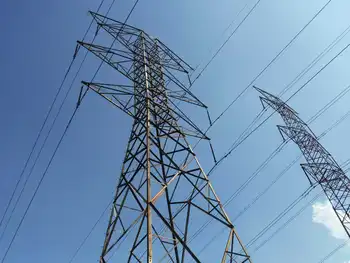The social responsibility of coal
By Canada Free Press
Arc Flash Training - CSA Z462 Electrical Safety
Our customized live online or in‑person group training can be delivered to your staff at your location.

- Live Online
- 6 hours Instructor-led
- Group Training Available
It’s not easy, due to the nature of their business, public intolerance for any ecological impacts – and the fact that “corporate social responsibility” is often defined and used by activist groups to promote ideological agendas.
Above all, activists want to engineer a “wholesale transformation” of our energy and economic system, away from hydrocarbon fuels and into “eco-friendly” renewable resources; reduce our living standards to “sustainable” levels (their definition again); and give them power over the power that sustains our modern society.
This “hard green” version of Corporate Social Responsibility (CSR) largely ignores socio-economic considerations, the many benefits of fossil fuel and nuclear power, the significant land and environmental impacts of wind, solar and ethanol – and the oppressive effects of soaring energy prices on jobs and poor families.
Speaker Nancy Pelosi closed down the House of Representatives on August 1, to avoid an energy vote that Democrats would have lost, and later displayed her acumen on the subject when she opined: “natural gas is a clean, cheap alternative to fossil fuels.” News flash: Natural gas is a fossil fuel.
An Energy Economics 101 course is clearly needed, so that members of both parties can legislate more astutelyÂ… understand why mining and burning coal is a socially responsible component of sound energy policyÂ… and help stanch the unnecessary flow of $700 billion a year in foreign oil payments.
Energy is the master resource, the foundation for everything we eat, use and do. Sound policies ensure that energy is abundant, reliable and affordable. Restricting supplies in the face of rising global demand drives up prices and sends shockwaves through families, industries, communities and nations.
Average total energy costs for a typical American household doubled from $2,400 in 1997 to over $5,000 in 2007. Food prices also soared, while wages remained stagnant. More low and middle income families have been forced to choose between heating, eating, driving, medicines and rent – with little left over for vacations, emergencies, retirement, college or charity.
Thankfully, most electricity bills rose more modestly, because half of all U.S. electricity is generated using coal, and the price for that fossil fuel has risen far less than oil, gasoline and natural gas prices.
However, in places like Florida – where coal is verboten, natural gas is promoted but drilling for it is banned, and wind and solar are all the rage – electricity prices continue to climb. Florida Power & Light must pay four times as much for photovoltaic power as for coal power, the Heartland Institute reports, and schools face budget crunches for buses and electricity.
America has centuries’ worth of coal. Our reliance on this resource has tripled since 1970 – but sulfur dioxide and particulate emissions are down 40% and 90% below 1970 levels, respectively, notes air pollution expert Joel Schwartz. New technologies and regulations will reduce coal power plant emissions even further by 2020, but even current emissions (including mercury) pose no significant risks to human health, he emphasizes.
Radical environmentalists worry and wail about speculative health risks, to justify anti-coal campaigns. But their concerns often disappear when the discussion shifts to millions of Africans who die every year from real, preventable lung and intestinal diseases that result from an absence of electricity for cooking, heating, refrigeration, safe drinking water, hospitals and decent living standards.
Wind and solar will save few of those lives – and yet green pressure groups stridently oppose fossil fuel, nuclear and hydroelectric power for Africa.
U.S. electricity consumption will continue climbing, even with conservation, because our population and technology use are increasing steadily. Meanwhile, 59 coal-fired plants were cancelled in 2007 thanks to eco-activists, who are challenging 50 more.
The United States now has virtually no excess capacity, and switching to natural gas as a primary power plant fuel (and fuel for backup generators to support wind farms) means electricity prices could increase “as much as tenfold,” says energy analyst Mark Mills, especially if we continue to ban drilling.
“After that we may see forced conservation, or even blackouts in rotation among business and residential customers.”
Energy shortages and price hikes could cost millions of jobs in the automotive, airline, tourism, food and beverage, textiles, paper making, plastics, chemicals, metals and manufacturing industries – especially if Congress also enacts cap-and-trade rules. Most will never be replaced by “green collar” jobs that some claim will be created by intermittent, unreliable wind and solar energy.
Switching to plug-in hybrid cars will only exacerbate the problem. They will need a well-stocked power grid to plug into, and current energy policies virtually ensure that it wonÂ’t be there.
In addition to balance of trade issues, over-reliance on imports has major national security implications, as RussiaÂ’s invasion of Georgia forcefully reminded Europe.
Germany imports 40% of its natural gas from Russia, and six Eastern European countries are entirely dependent on Mr. PutinÂ’s energy. Shackled further by their opposition to nuclear power, fear of climate change Armageddon and fixation on the Kyoto Protocols, the EU has barely protested actions by a rogue bear that has already cut off natural gas supplies to Latvia, Lithuania and the Czech Republic, to impose its will.
That should cause Congress to reflect more soberly on U.S. dependence on oil from Venezuela, Nigeria, Iran and Russia. Coal could be converted into synthetic liquid and gas fuels, to replace the oil and gas we refuse to develop, but legal and regulatory hurdles restrict that option, too.
A key justification for these anti-energy policies is cataclysmic global warming.
However, 32,000 scientists have signed the Oregon Petition, saying they see “no convincing evidence” that humans are causing climate change, or that it will be catastrophic. Climate models continue to predict chaos but, as one scientist wryly notes, faith in their predictions is as misplaced as reliance on emails from Nigeria, advising recipients that they have won the lottery.
Global temperatures have not increased since 1998, despite steadily increasing carbon dioxide levels, and solar scientists like Pal Brekke say the sunÂ’s formerly high activity level is leveling off or abating, which could bring falling global temperatures.
China and India are planning or building 700 coal-fired power plants; European countries plan to build 50 more in five years, to reduce dependence on Russian gas; and other nations are also increasing fossil fuel use for transportation and power generation.
Thus, no matter how much the United States reduces its energy use, driving, heating, air-conditioning and living standards – no matter how much it punishes poor families or commits economic suicide – its actions would not reduce global CO2 levels, or affect Earth’s climate.
We need to conserve, and continue improving renewable energy technologies that currently provide just 0.5% of our energy. But at this time renewables are simply too inefficient, expensive and unreliable to permit a shutdown of hydrocarbon-based systems.
Putting “social responsibility” and “environmental justice” in the hands of eco-activists and liberal Democrats is like giving a machine gun to an idiot child. We need definitions that recognize the full spectrum of societal needs, and energy policies that acknowledge life in the real world.











